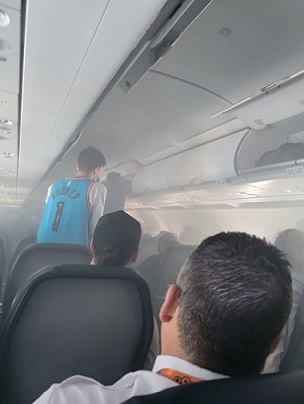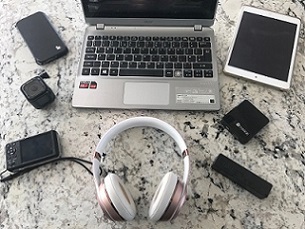 Lithium battery fires can quickly fill an aircraft passenger cabin with toxic smoke
Lithium battery fires can quickly fill an aircraft passenger cabin with toxic smoke
 The AvSax lithium battery fire mitigation bag which won the Queen’s Award for Enterprise for its innovation
The AvSax lithium battery fire mitigation bag which won the Queen’s Award for Enterprise for its innovation
 All these personal electronic devices are powered by lithium batteries
All these personal electronic devices are powered by lithium batteries
 Richard Bailey, managing director of Environmental Defence Systems Ltd, who invented the AvSax
Richard Bailey, managing director of Environmental Defence Systems Ltd, who invented the AvSax
Airline passengers are now bombarded with information on how to transport lithium batteries safely on aircraft … but no-one seems to reveal what happens if a fire actually breaks out on board.
The mainstream media and the airlines remind people to always carry their lithium batteries in their hand luggage and to never stow it in baggage going into the luggage hold.
But why is this and what happens should the worst happen and a lithium battery overheats, smoulders, sets on fire or even explodes?
There are hundreds of lithium batteries on board every flight as they are used to power all our everyday personal electronic devices such as mobile phones, iPads, vapes and portable power chargers.
They can and do overheat and catch fire, especially as many are bought on the internet from all over the world, not realising that some fail to meet safety standards.
More than 100 airline operators worldwide are now equipped with AvSax lithium battery fire mitigation bags which means they are on board almost 17,000 aircraft and every time they’ve been used in action the aircraft has been able to continue its journey without having to make a costly diversion and emergency landing.
When a lithium battery overheats it goes into what’s known as thermal runaway, a rapid, uncontrolled chemical reaction within the battery that causes the internal temperature to rise.
When one cell in a battery overheats it can produce enough heat - up to 900°C (1652°F) - to make adjacent cells overheat. This can cause a lithium battery fire to flare repeatedly which is why AvSax fire and smoke mitigation bags are needed.
The AvSax ‘burnbag’ can minimise the danger in seconds from fire, immense heat and toxic smoke as they are manufactured from military grade material.
Simply pour at least two litres of water into an AvSax fireproof battery containment bag and then drop the overheating device into it. The water activates the polymer gel inside the bag causing it to expand around the device.
Should the device keep on venting or even explode then the AvSax fire mitigation bag is tough enough to absorb the force and the danger is all contained within it. Miraculously, if the device cools down the water won’t affect it as it’s absorbed into the sides of the bags and so the device should be undamaged and can be used again.
AvSax were invented by Richard Bailey, managing director of Environmental Defence Systems Ltd based in Huddersfield, Yorkshire, England, and won the highest accolade any business can get, the Queen’s Award for Enterprise, for their innovation.
Richard said: “AvSax are yellow and highly distinctive but are stowed out of sight unless there is an emergency so the vast majority of airplane passengers will never see one.
“Although lithium battery fires remain rare on aircraft compared to the number of flights every day worldwide, they can and do happen. Every time an AvSax has been used in action the aircraft has been able to continue its journey to its scheduled destination. Aircraft without AvSax often need to divert and make emergency landings at the nearest airport which can be very costly for the airline company and highly disruptive for passengers. AvSax prevents all that.”
AvSax is the only thermal fire containment bag that works using water or similar liquids and this use of liquid is recommended by the Civil Aviation Authority in the UK.
In its guidance the CAA states: “Since the development of the International Civil Aviation Organization (ICAO) guidance on dealing with an in-flight battery fire, new products designed for use in response to lithium battery thermal runaway events have become available.
“Products which provide both a cooling and containment capability are typically more aligned to the existing ICAO guidance as when used they are filled with water or other non-flammable liquid to act as a cooling agent.
“After knocking down flames it could conceivably take just a couple of seconds for a personal electronic device to be placed inside a containment bag, allowing it to be moved to a place of safety. Passengers could then return to their seats, mitigating potential unrelated safety hazards such as injury in the case of severe turbulence. Equally, the effect on flight crew in carrying out their duties following an event on the flight deck would be minimised.”
There have been 483 verified lithium battery incidents on US aircraft or planes in US airspace between March 2006 and April 2024, according to the Federal Aviation Administration.
Of these, 201 involved battery packs, 100 were caused by vapes or e-cigarettes, 63 were mobile phones, 59 laptops and the rest from other personal electronic devices.
For more information on AvSax go to https://avsax.com/